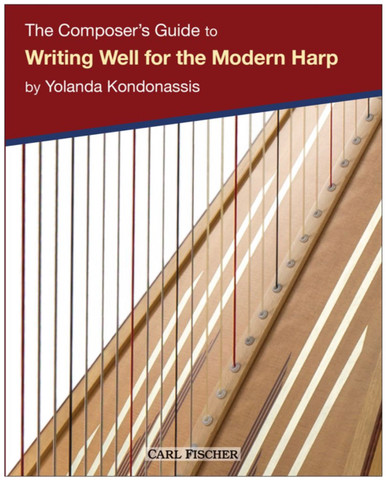Cletus McBone
(aka: R.G.)
Answering a harp question here to avoid being way OT in the Momentum thread:
The most meaningful two things for me were to take 40 hours of "composer harp" lessons about a dozen years ago. (N.B., In no way do I consider myself a harpist even by half of half.) Around the same time I joined a local harp society for a year; there's one in just about every decent size American city. So once a month I'd go in with three or four short (ca. 1:00) harp pieces and pass around multiple copies to whoever wanted to look them over in their leisure—many harpists love this—and I received lots of valuable feedback.
For intermediate harp, Carl Fischer sells a few books of Marcel Tournier compilations, modern edits by two harpists.
For advanced and virtuoso harp (some of these are shortened names):

(N.B., You shouldn't use the notation and engraving on these as modern standards unless you find a well-edited modern version. In fact, you shouldn't use the notation and engraving in orchestral harp parts as gospel, either.)
Salzedo's 5 Poetical Studies (Novato Music Press) is a good place to start, as each movement is based on exploiting a particular aspect of harp technique. The Alice Giles recording is very good. But be aware that Salzedo notated his harmonics the old-fashioned way, at pitch rather than at string, so you have to account for that.
The Parish-Alvars La Mandoline is a big mountain for harpists, and some harpists use a Paraguayan trino to pull it off.
The pieces above were written by male harpists (although Ravel wasn't a harpist), so now and then you'll come across something that's a problem for those without large hands and requires a workaround. If used at all, such figures should be rare, and confined to virtuoso level pieces. Not something you want to try out in an orchestral harp part without an ossia.
For orchestral harp parts, Ravel's your safest bet idiomatically, though even he still needs a bit of harpist help now and then, and some of his parts are challenging enough to be ill-advised for any type of read-and-record session unless the harpist has the part beforehand by a few days at at least.
Conceptually speaking, Ravel, Stravinsky, Debussy and Dukas (very French lopsided) are great places to start. They treat the harp as something more than the occasional "added color and flourish" pushbutton.
Book-wise, Sarah Bullen, CSO harpist, has two books, each with a CD. They're written for harpists, and they have her edited versions of orchestral harp parts that are commonly known to need various types of fixes. She includes fingerings, which are also very important for composers to study (but of course composers do not include fingerings in their parts). Comparing her versions to the originals is how composers can learn about things to avoid and ways to improve. So...
Principal Harp, Book 1 (and book 2), by Sarah Bullen, (Vanderbilt Music Company).
A good reference book is Master Glossary of Symbols and Special Effects for Harp, by Faith Carman, (also Vanderbilt).
____________________
Overall, understanding the basis of harp technique, which is placement and fingering, can help you minimize problems for your harpist, but that would need its own post.
Also, when you consult with harpists, or any other harp resource, try to consult with more than just one, because some issues run according to preference, and according to whether the target is for a concert stage orchestral harp part, or a studio one, or a virtuoso level solo or concerto, which makes it impossible to go on just one opinion for some things. Whether its notation, finger span, righthand range, et cetera.
One last thing, the cleaner and more idiomatic your harp part, the better the harpist will play with confidence and projection. That's how it works with harpists. And harp balance in an orchestral setting is always a challenge to overcome.
____________________
...are there any scores or resources that you recommend on the subject?
The most meaningful two things for me were to take 40 hours of "composer harp" lessons about a dozen years ago. (N.B., In no way do I consider myself a harpist even by half of half.) Around the same time I joined a local harp society for a year; there's one in just about every decent size American city. So once a month I'd go in with three or four short (ca. 1:00) harp pieces and pass around multiple copies to whoever wanted to look them over in their leisure—many harpists love this—and I received lots of valuable feedback.
For intermediate harp, Carl Fischer sells a few books of Marcel Tournier compilations, modern edits by two harpists.
For advanced and virtuoso harp (some of these are shortened names):

(N.B., You shouldn't use the notation and engraving on these as modern standards unless you find a well-edited modern version. In fact, you shouldn't use the notation and engraving in orchestral harp parts as gospel, either.)
Salzedo's 5 Poetical Studies (Novato Music Press) is a good place to start, as each movement is based on exploiting a particular aspect of harp technique. The Alice Giles recording is very good. But be aware that Salzedo notated his harmonics the old-fashioned way, at pitch rather than at string, so you have to account for that.
The Parish-Alvars La Mandoline is a big mountain for harpists, and some harpists use a Paraguayan trino to pull it off.
The pieces above were written by male harpists (although Ravel wasn't a harpist), so now and then you'll come across something that's a problem for those without large hands and requires a workaround. If used at all, such figures should be rare, and confined to virtuoso level pieces. Not something you want to try out in an orchestral harp part without an ossia.
For orchestral harp parts, Ravel's your safest bet idiomatically, though even he still needs a bit of harpist help now and then, and some of his parts are challenging enough to be ill-advised for any type of read-and-record session unless the harpist has the part beforehand by a few days at at least.
Conceptually speaking, Ravel, Stravinsky, Debussy and Dukas (very French lopsided) are great places to start. They treat the harp as something more than the occasional "added color and flourish" pushbutton.
Book-wise, Sarah Bullen, CSO harpist, has two books, each with a CD. They're written for harpists, and they have her edited versions of orchestral harp parts that are commonly known to need various types of fixes. She includes fingerings, which are also very important for composers to study (but of course composers do not include fingerings in their parts). Comparing her versions to the originals is how composers can learn about things to avoid and ways to improve. So...
Principal Harp, Book 1 (and book 2), by Sarah Bullen, (Vanderbilt Music Company).
A good reference book is Master Glossary of Symbols and Special Effects for Harp, by Faith Carman, (also Vanderbilt).
____________________
Overall, understanding the basis of harp technique, which is placement and fingering, can help you minimize problems for your harpist, but that would need its own post.
Also, when you consult with harpists, or any other harp resource, try to consult with more than just one, because some issues run according to preference, and according to whether the target is for a concert stage orchestral harp part, or a studio one, or a virtuoso level solo or concerto, which makes it impossible to go on just one opinion for some things. Whether its notation, finger span, righthand range, et cetera.
One last thing, the cleaner and more idiomatic your harp part, the better the harpist will play with confidence and projection. That's how it works with harpists. And harp balance in an orchestral setting is always a challenge to overcome.
____________________





